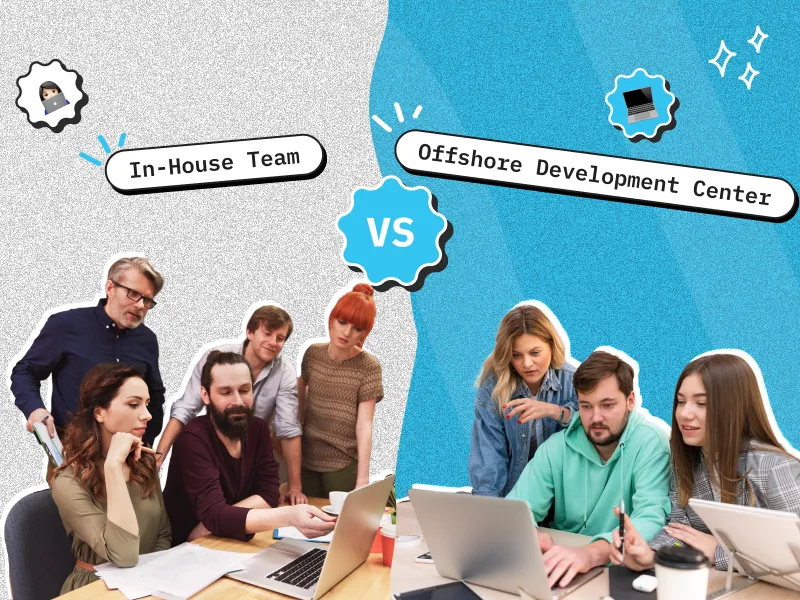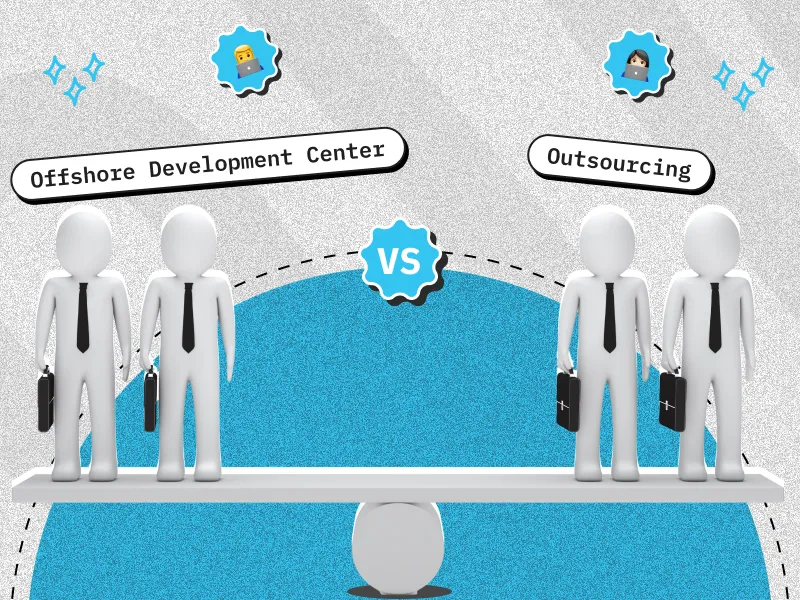Quick Summary:
Choosing between an In-House Team vs. Offshore Development Center depends on business needs, budget, and project scope. In-house teams offer greater control, seamless collaboration, and alignment with company culture, but come with higher costs and slower scalability. Offshore Development Centers provide cost efficiency, access to global talent, and flexibility, but can face communication and security challenges. Businesses must assess project requirements, technology needs, and long-term goals to make the right choice, potentially leveraging a hybrid model for optimal results.
Understanding the Concepts
What is an In-House Development Team?
An in-house development team is composed of developers who are employed directly by the organization. They work within the company’s physical premises and are integrated into its existing team structure. One of the core features of in-house teams is their close alignment with the company’s culture and values. This alignment ensures that the development work aligns with the overarching business objectives. Additionally, being physically present allows seamless collaboration with other departments, leading to improved synchronization and project execution. In-house teams also enable direct oversight and tighter control over ongoing projects, ensuring that deliverables meet the precise requirements of the organization.
What is an Offshore Development Center (ODC)?
An Offshore Development Center (ODC) is a dedicated team located in a foreign country. The ODC operates as an extension of the company’s business, focusing on software development and related tasks. Setting up an ODC involves sourcing talent from global talent pools, where companies can leverage the skills and technical expertise that might be scarce or more expensive locally. An ODC is especially beneficial for companies looking to reduce costs without compromising on quality by tapping into countries with lower labor costs. The purpose of an ODC extends beyond mere cost savings. It aims to provide companies with flexibility in scaling operations, thus making businesses more adaptive to changing project requirements and market expectations.
Pros and Cons of In-House Development
Advantages of In-House Teams
Greater control and oversight:
Having team members on-site allows managers to directly monitor project progress, adjust priorities in real time, and ensure that the deliverables align closely with expectations. This control helps maintain high-quality outputs and quick resolution of issues.
Better communication due to proximity:
Face-to-face interactions eliminate delays in communication, foster better understanding, and enable instant feedback loops. This ensures smoother collaboration and minimizes the risk of misinterpretation or project delays caused by remote communication barriers.
Stronger alignment with company culture:
In-house teams naturally assimilate the company’s values, mission, and goals. This shared understanding often leads to outcomes that resonate well with the organization’s brand identity and strategic objectives.
Easier collaboration with other departments:
With physical proximity to other teams, in-house members can easily connect with marketing, sales, or support departments to exchange ideas, share updates, and streamline cross-functional workflows. This fosters a collaborative work environment and efficient problem-solving.
Long-term skill development within the organization:
In-house teams benefit from a sustained investment in their professional growth. As employees gain experience and undergo training over time, they become specialized experts and invaluable contributors to the company’s success.
Read More: Top 10 Benefits of Offshore Development services in 2025
Disadvantages of In-House Teams
Higher operational costs (salaries, infrastructure, benefits):
Running an in-house team demands significant financial resources, including competitive salaries, office space, equipment, and benefits packages. These recurring expenses can strain budgets, especially for smaller businesses.
Limited access to diverse talent pools:
Relying solely on local recruitment restricts access to a global pool of talent. This limitation can make it difficult to hire experts in emerging technologies or niche fields, potentially hindering innovation and growth.
Slower scalability in response to sudden demands:
Expanding an in-house team involves time-consuming processes such as recruitment, onboarding, and training. This can make it challenging to quickly scale up the workforce to meet tight deadlines or handle sudden project surges.
Risk of skill stagnation:
Without regular exposure to new challenges or training programs, in-house team members may struggle to stay up-to-date with the latest technologies and trends. This could lead to a decline in overall team performance and competitiveness.
Pros and Cons of Offshore Development Centers
Advantages of Offshore Development Centers
Cost efficiency without compromising quality:
Offshore Development Centers (ODCs) enable businesses to lower operational expenses by hiring skilled professionals from regions with competitive labor costs. This approach allows companies to maintain high-quality standards without overshooting their budgets, making it an attractive option for cost-conscious enterprises.
Access to a global talent pool with niche expertise:
ODCs provide access to a diverse pool of professionals worldwide, offering specialized skills that may be unavailable locally. This global reach empowers businesses to tackle complex projects and adopt emerging technologies effectively, ensuring project success.
Scalability and flexibility to adapt to project needs:
Offshore teams can be quickly scaled up or down based on the project’s requirements, offering unparalleled flexibility. This adaptability ensures that businesses can respond to changing market demands or project scopes without the challenges of permanent hiring.
Faster time-to-market through 24/7 development cycles:
By leveraging teams in different time zones, ODCs enable continuous development around the clock. This “follow-the-sun” model accelerates delivery timelines, helping businesses achieve faster time-to-market and stay competitive in dynamic industries.
Reduced administrative and HR overhead:
ODCs alleviate the burden on internal HR and administrative teams by handling recruitment, onboarding, and team management processes. This streamlining allows companies to focus on core operations while reducing associated overhead costs.
Disadvantages of Offshore Development Centers
Potential communication and collaboration challenges:
Working across different time zones and languages can lead to delays in communication and misaligned expectations. Addressing these gaps requires clear protocols, tools, and practices to ensure seamless collaboration between teams.
Cultural and time zone differences:
Diverse cultural norms and time differences may affect work processes, expectations, and team dynamics. Bridging these gaps involves fostering mutual understanding and creating strategies to synchronize efforts effectively.
Security and intellectual property risks:
Outsourcing development functions introduces risks related to data security and intellectual property. Companies must implement strict legal agreements, robust cybersecurity measures, and regular audits to safeguard sensitive information.
Dependency on external teams for critical functions:
Relying on offshore teams for key business functions can create vulnerabilities, such as reduced control over deliverables or inconsistencies in performance. Establishing strong partnerships and backup plans is essential to mitigate this dependency.
Key Factors to Consider: In-House vs Offshore Teams
Cost Implications
When considering the cost implications of an in-house team vs offshore development center, it’s crucial to assess the expenses involved. In-house teams generally require significant investment in salaries, benefits, and physical infrastructure. On the other hand, offshore centers can offer a more cost-effective solution due to lower labor costs in different regions. These savings can be substantial, particularly for startups and businesses with budget constraints.
Quality and Expertise
The quality and expertise available can greatly influence the decision. In-house teams offer the advantage of direct oversight and can be carefully curated to match specific company requirements. However, offshore development centers offer access to a broader pool of global talent, often providing niche expertise that may not be readily available locally. This could be highly beneficial for specialized project needs.
Speed and Scalability
In terms of speed and scalability, offshore development centers often have the upper hand. Their ability to provide round-the-clock services due to varying time zones results in faster project turnaround times. Moreover, scalability is more easily achieved as businesses can quickly adjust team sizes to meet project demands. In contrast, in-house teams may face delays due to the time involved in hiring and training.
Communication and Collaboration
Communication and collaboration are vital factors. An in-house team benefits from immediate and direct communication, minimizing misunderstandings and fostering strong team dynamics. On the other hand, offshore teams might face challenges due to time zone differences and potential language barriers. However, advancements in digital communication tools have mitigated many of these challenges, enabling smooth virtual collaboration.
Security and Intellectual Property
When it comes to security and intellectual property, having an in-house team often feels more secure for many companies. The direct control and oversight reduce the risk of data breaches or intellectual property theft. However, with robust contracts and security protocols, offshore development centers can effectively manage these concerns, providing peace of mind to businesses about their data safety.
Alignment with Business Goals
Lastly, choosing between an in-house team vs offshore development center should involve aligning with the company’s long-term vision. In-house teams are typically seen as a long-term investment, supporting future expansion and maintaining continuity. Offshore teams, meanwhile, can offer flexibility and adaptability, allowing businesses to pivot quickly in response to market changes and opportunities.
Step-by-Step Guide to Choosing In-House or Offshore Teams
Assess your business needs and budget:
Begin by identifying your priorities and financial boundaries. If maintaining direct control and oversight over your team is essential, an in-house model might be more suitable, even if it requires higher spending. Conversely, if cost efficiency without compromising quality is paramount, an offshore development center could be the better option. Carefully analyze what aligns best with your operational strategy and available resources.
Evaluate the project scope and timeline:
Understand the size, complexity, and urgency of your project. Large-scale projects with flexible timelines might benefit from in-house teams due to their continuity, while time-sensitive projects requiring 24/7 development cycles may thrive with offshore teams. Ensure your choice aligns with both immediate deliverables and overarching project milestones.
Consider the complexity of the required technology:
Examine the technical demands of your project and assess whether your existing team can meet them. If advanced or niche technologies are required that your local talent lacks, offshore development centers can provide the specialized expertise needed. Weigh the cost and feasibility of acquiring such skills locally versus tapping into a global talent pool.
Weigh the importance of proximity and collaboration:
Evaluate how critical face-to-face interactions and immediate feedback are for your project. If proximity is crucial for fostering creativity and collaboration, an in-house model may work best. However, if your organization can effectively utilize digital tools for seamless communication, geographical separation with offshore teams might not pose a significant challenge.
Balance short-term goals with long-term growth strategies:
Decide whether your focus is on achieving immediate project goals or building a sustainable, long-term team. Offshore centers can address short-term scalability needs and cost reductions, while in-house teams contribute to the long-term growth of institutional knowledge and alignment with company culture. Align your decision with both your current objectives and future aspirations.
Conclusion: Finding Your Perfect Fit
Deciding between an in-house team vs offshore development center is a nuanced decision that depends heavily on individual business needs, resources, and strategic goals. Both models come with distinct advantages and limitations, and the choice ultimately lies in aligning with the company’s vision, operational focus, and growth trajectory. Businesses should meticulously evaluate their unique circumstances to make an informed choice, potentially leveraging a hybrid model that optimizes benefits from both.
Frequently Asked Questions (FAQs)
What is the difference between an offshore development center and an in-house team?
An offshore development center typically offers cost savings by leveraging global talent, with potential challenges in communication and time zone differences. In contrast, an in-house team provides direct oversight and control but can be more expensive and less flexible.
What is the difference between an offshore team and an onshore team?
An offshore team is located in a different country, often providing cost advantages due to lower labor costs. An onshore team, however, operates within the same country, offering easier communication and proximity but at higher costs.
What is the difference between offshore and in-house?
Offshore teams are based in different regions, typically for cost-effectiveness and access to specialized skills, whereas in-house teams work directly within the company’s facilities, ensuring close collaboration but with higher overhead costs.
How do you manage an offshore development team effectively?
To manage an offshore development team effectively, use digital communication tools, establish clear expectations, maintain regular check-ins, ensure time zone overlap, and implement strong security protocols to safeguard intellectual property and data.
What types of projects are best suited for ODCs vs. in-house teams?
Projects requiring quick scalability and specialized expertise are ideal for ODCs, while in-house teams are better for projects needing direct oversight and seamless collaboration.
How do you ensure data security with an offshore team?
Implementing robust security protocols, confidentiality agreements, and regular audits can safeguard data in offshore collaborations.
What are the costs involved in setting up an ODC?
Costs include hiring, infrastructure, legal and compliance fees, and ongoing management expenses.
How can businesses mitigate cultural and communication challenges in offshore collaborations?
Using advanced collaboration tools, fostering cultural awareness, and scheduling regular interactions can bridge the gap in offshore engagements.














 30 mins free Consulting
30 mins free Consulting 
 13 min read
13 min read 







 Love we get from the world
Love we get from the world 